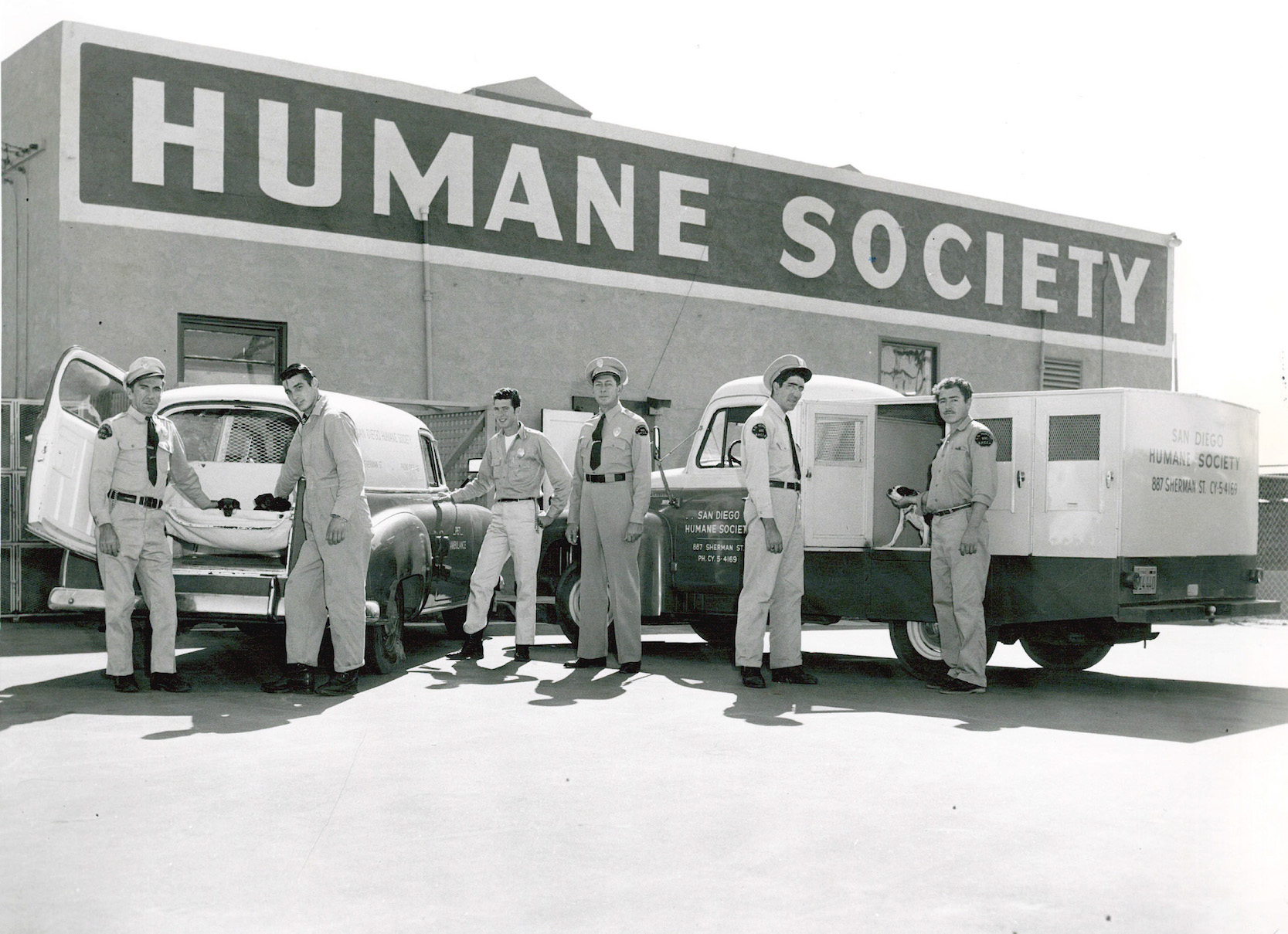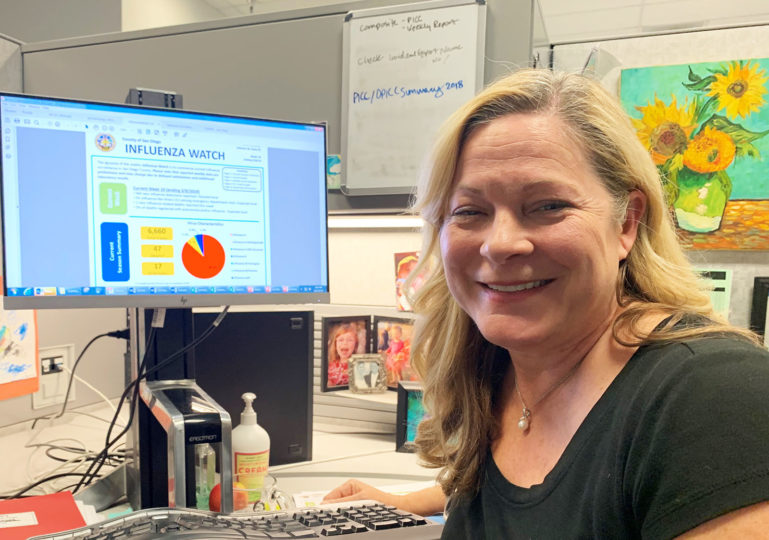Daily Business Report-March 29, 2019
Brit Colanter is an epidemiologist with Public Health Services at the county Health and Human Services Agency. (Photo courtesy of County of San Diego)
How electronic data helps
protect the public from influenza
By Jose A. Alvarez | County of San Diego Communications Office
How bad is the flu season?
Were any flu-related deaths reported last week?
Did the number of flu cases go up or down? How about the percentage of people at local emergency rooms with influenza-like symptoms?
These are the main questions that Brit Colanter, an epidemiologist with Public Health Services at the County Health and Human Services Agency (HHSA), must find answers for year-round to determine how influenza is impacting residents in the region.
To do that, she turns to several County systems that collect electronic health information and lab results from the local medical community on influenza and dozens of other infectious diseases.
These systems include the communicable disease registry and other electronic health data systems . Colanter and her colleagues analyze the data on a weekly basis to determine how influenza is impacting the local community.
The analysis is turned into HHSA’s weekly Influenza Watch report, which tracks key flu indicators and summarizes influenza activity in the region. The report is issued every Wednesday from October to April primarily to the medical community, but members of the public and the media can also register to receive it.
The data crunching requires a lot of packaging that results in spreadsheets, tables and graphs that inform county doctors about influenza activity at any week during the season and what trends are being detected.
“Now we have more robust electronic records which allow us to have comparable data from season to season.”
For Colanter, the data behind the Influenza Watch report are like pieces of a puzzle that help to describe for the medical community what is happening in relationship to influenza.
“I love it,” said Colanter, who’s been with HHSA for 15 years and has a master’s degree in public health epidemiology from San Diego State University. “Public health is a great place to be. I have always been interested in infectious diseases.”
Data on Influenza Deaths
On influenza-related deaths, the County collects as much data as possible, but privacy is protected, and the information released to the public is limited. What is reported is the date of death, the age and gender of the person who died, the type of influenza involved, as well as the region of the county where they lived and whether they had underlying medical conditions or had been vaccinated.
To get all this info, Colanter looks at electronic medical records, the San Diego Regional Immunization Registry, and death certificates that are filed with the County’s Office of Vital Records and Statistics.
The lab-confirmed influenza cases come from local hospital labs and private medical labs, as well as the County Public Health Lab and community clinics, which also serve as influenza sentinel sites. Much of the lab data is reported through electronic lab interfaces with local hospital labs.
The cases are then divided by flu strain, which this season has predominantly been influenza A Pandemic H1N1, although the region has now started to see an increase in influenza A H3N2.
Local emergency departments also report the percentage of patients reporting influenza-like illness, which Colanter compiles to provide a weekly percentage for the region.
Protecting the Public’s Health
Although only pediatric deaths and influenza outbreaks are required to be reported to local health departments in California, the County encourages voluntary reporting of all lab-confirmed influenza cases so it can provide a more detailed and accurate picture of flu activity. These reports help to identify flu outbreaks and deaths. The close connection to the local medical community allows the County to provide extensive analysis on influenza.
“We have really good relationships with our local hospitals and providers,” said Colanter, who in years past had to call emergency departments each week to collect their percentage of influenza-like illness. “Now we have more robust electronic records which allow us to have comparable data from season to season.”
The County’s electronic data collection enables Colanter and other County epidemiologists to provide timely and detailed internal and external reports, not just on influenza, but on other infectious diseases that occur in the region.
Recently, Colanter prepared an extensive flu case count and influenza-like illness report for each week of the past 11 influenza seasons. Both reports were created at the request of the local daily newspaper.
“The data we provide helps inform local residents and to protect the public’s health,” Colanter said.
__________________
Region’s larges real estate conference and expo
returns to the San Diego Convention Center May 10
The largest real estate trade show in San Diego comes to the San Diego Convention Center on Friday, May 10. The Elevate Real Estate Conference and Expo brings together more than 3,000 agents, brokers and other industry professionals for a day of networking, education, and inspiration for their business.
The event will look at real estate in 2020 and beyond. Topics will focus on what the industry is doing to embrace the future of real estate as it applies to new technology, industry disruptors, buying habits, and customer expectations. The industry is changing, and you don’t want to be left behind!
The Greater San Diego Association of Realtors announced that the General Session will feature real estate visionary Stefan Swanepoel. The internationally respected business executive has been president/CEO of a real estate brokerage, a global real estate franchise, a national Realtor association, an MLS organization, and a technology startup.
The Elevate Real Estate Conference and Expo also includes a trade show in the Sail Pavilion of the Convention Center with more than 200 industry exhibitors, education breakout sessions on timely topics such as lead generation and real estate technology, plus raffles, giveaways, and a happy hour for attendees and exhibitors to close out the conference.
What: San Diego’s Elevate Real Estate Conference & Expo
Who: Real Estate Professionals and Industry Vendors
When: Friday, May 10, 9 a.m. to 5 p.m.
Where: San Diego Convention Center, 111 W. Harbor Dr., San Diego, CA 92101
Cost: $40 All Access: General Session, Expo Trade Show & Breakout Sessions
For more information and registration: www.sdarexpo.com
__________________

San Diego Humane Society to shutter
Sherman Street facility on Sunday
On Sunday, San Diego Humane Society will say goodbye to its location on Sherman Street, which provided homeless animals with care for 68 years. The city of San Diego purchased the property for its Pure Water program in 2018. San Diego Humane Society’s lease with the city will expire on Sunday.
San Diego Humane Society was established in 1880. On July 27, 1951, the first SDHS animals were moved into 887 Sherman St. in Linda Vista, which had formerly been a milk plant.
“Sherman has always been the rock,” said President and CEO Dr. Gary Weitzman. “It’s the place where our programs were born.”
Sherman Street was the home of San Diego Humane Society’s Humane Law Enforcement division, Project Wildlife and the Behavior Center, where trainers worked with animals exhibiting behavior challenges to prepare them for adoption. Adoptions were also based at Sherman Street until San Diego Humane Society moved into its current facility at 5500 Gaines St. in 2003.
SDHS Humane Law Enforcement moved to the Gaines Street facility in 2018, and then Project Wildlife followed in March 2019 with the opening of the state-of-the-art Pilar and Chuck Bahde Wildlife Center. SDHS’s Behavior Center is set to open in a new facility at Gaines Street this summer.
__________________
County Supervisors approve long list
of roadwork to qualify for state funds
The San Diego County Board of Supervisors approved an 11-page list of roadwork at Wednesday’s board meeting to send to the state to qualify for an expected $39.5 million in funding from California’s 2017 Senate Bill 1 gas tax, the Road Repair and Accountability Act.
In a separate action, the board also received a report from the county’s Department of Public Works identifying potential cost-effective and environmentally sustainable ways to build and protect county roads.
The list of roads approved by the board includes 144 miles of resurfacing projects in numerous unincorporated communities, some of which include Alpine, Bonita, Bonsall, Borrego, Boulevard, Campo/Lake Morena, Descanso, Fallbrook, Jamul, Julian, Lakeside, Pala, Pine Valley, Ramona, San Dieguito, Spring Valley and Valley Center. The projects are expected to be completed by the end of 2020. The county anticipates receiving a total of $538 million in SB 1 funds over 10 years.
The board also accepted a report, Building Better Roads, that Public Works created with a working group that included representatives from the department, other public agencies and industry associations.
__________________
Small Business Procurement Conference
to be staged April 3 at Naval Training Center
Small businesses interested in pursuing government contracts should register to attend on of the “Getting Back 2 Business” Small Business Procurement Conferences. The next one is Wednesday, April 3, from 8 a.m. to 5 p.m. at the Naval Training Center, Building 177, 2875 Dewey Road, San Diego. The U.S Department of Health and Human Services Office of the Secretary, Office of Small and Disadvantaged Business Utilization is hosting the event. Click here to register.
__________________

Controversial Plum Street house
on the market for $2.8 million
sdnews.com
A contemporary-style, newly rebuilt mansion in Point Loma, which was a “perpetual remodel” under construction for more than seven years at 1676 Plum St., is on the market with a $2.8 million price tag.
The home was sold to a local dentist following court action against the structure’s builder and previous owner, Francisco Mendiola. In December 2015, the court gave Mendiola a Jan. 7 deadline to either complete his unfinished mansion, dispose of the property or go to jail.
A real estate listing notes the Plum Street manse is nestled on a quiet street with unique 120- to 150-degree views of Point Loma, Downtown, San Diego Bay and Coronado Island. The dwelling offers an open living room and kitchen with high-end JennAir Appliances.
__________________

Pacific Building Group completes project
in Sorrento Valley for Gravity Heights Brewery
General Contractor Pacific Building Group has completed construction on a new, 12,000- square-foot shell building in which Gravity Heights, WisknLadle Hospitality’s newest restaurant, calls home.
The two-level building, which is located at 9920 Pacific Heights Blvd. in Sorrento Valley, includes architecturally exposed steel beam construction, custom sliding door systems, single hung windows, glass overhead door, alucobond panels, full-height glass curtain wall systems and a mezzanine with an ADA lift and exterior stair access. Pacific Building Group also performed extensive exterior work that included IPE fencing, a new driveway, new site lighting and landscaping, keystone retaining walls, modular wetlands water retention system and electric vehicle charging stations.
Pacific Building Group was an active partner in the collaborative planning team, which included Bollert LeBeau (owner), Serbia Consulting (construction manager), LPA Inc. (architect), and other key design consultants.
The 7,000-square-foot restaurant and brewery, which is now open for business, accommodates up to 400 guests, and private dining facilities are available on the mezzanine. An additional 5,000 square feet is dedicated to outdoor garden dining.
__________________
Commentary
For the privilege of helping others,
I will be paying off student loans for 20 years
By Anna Shoopman | Special to CALmatters
On the single day that I wrote this commentary, the net cost of my post-graduate studies increased from $22,960 to $23,258.
I am a first-semester masters of social work student at the University of Southern California, taking classes online, at a time when college tuition rates are higher than ever.
As my student loans rise, I ask myself, who is able to afford tuition?
One look into recent national news will make this clear. The college admissions scam, much of which involves parents of USC students, serves as a blaring signal that college is not about education. It is about status.
The majority of us do not have anyone to help buy our admission, let alone our education. I am one of the millions of Americans who will graduate with massive debt. By the time I earn my master’s degree in a year and a half, my student loans will amount to about $80,000. I fully expect to be working for 10 or 20 years to pay this off. This is the cost for me to become a social worker and help others.
There are innumerable others in this country who couldn’t afford to even think about higher education.
In 2016 a single mom with one child was considered to be in poverty if she earned less than $16,543 annually. Compare that to the average yearly tuition for a four-year public college, $20,967. Clearly, higher education is not geared toward anyone living in poverty. So I ask, again, who can afford higher education?
In 2015-2016, 72.3 percent of undergraduate students received some form of financial assistance. The remaining 28 percent are able to afford the full cost of tuition without assistance, and won’t be burdened with student loans that they will be paying off for years. These people become the elite.
As evidenced by the enormous cost of tuition today, education is not available to everyone, but rather specifically to the elite. The most expensive schools, the private schools, specifically serve this group.
They claim notoriety by charging astronomical tuition. Of course, they educate their students. But they also teach students how to gain and maintain social and economic status.
Too often, tuition serves to exclude less affluent students, and confine them to the middle class or less as they tirelessly work to escape student debt. This market drives the cost of education up, and simultaneously devalues the education of other students.
In an age in which money can and does buy the “best” education, we must take back the value of higher education by drastically reducing the cost, and making it affordable to people who aren’t the children of the rich and famous.
In order to reinstate the value of higher education, we must drop the ruse that college must be expensive to be worthwhile. We must create and support policies that provide incentives to lower the cost of tuition and increase institutional aid for students.
A start would be to increase admission rates by even slim margins to generate more revenue and drop the cost for each student.
Better yet would be to evaluate spending habits of unaffordable schools to better understand where costs can be reduced and tuition lowered. We have an obligation to understand how and where tuition is spent, so we can improve the system for the coming generation of students, no matter their parents income.
As a student who wants to enter a field where I have the privilege of helping others, I am on a specific path to a lifetime of hard but fulfilling work. I am taking on the cost of tuition in order to help those who bear the cost of a life without it. Although the cost of education is at an all time high, the cost of not addressing this issue is even higher.

Anna Shoopman is graduate student at the University of Southern California, shoopman@usc.edu, living in Tucson. She wrote this commentary for CALmatters, a public interest journalism venture committed to explaining how California’s Capitol works and why it matters.



